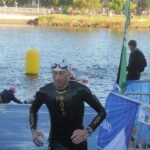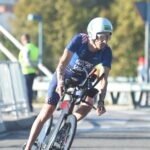Developing focus control is essential if you’re going to ensure that your focus style (as described in the July, 2010 issue of Prime Sport Alert!) helps rather than hurts your sports performance. There are several steps in the focus-control process. First, you have to identify your focus style and understand how it impacts your sport. Next, you must recognize internal and external cues that help and hurt your training and competitive performances. Finally, you have to adjust your focus internally and externally as needed during practice and competitions.
The Eyes Have it
We obtain most of our information about the world through our eyes. You can think of your eyes as Mag-Lite® flashlights that you can adjust to illuminate a wide area or brighten a narrow area. The most direct way to control your Mag-Lite® beams is to control your eyes. If you want to minimize the external distractions during practice or competitions, narrow your Mag-Lite® beam by keeping your eyes down and on the sport setting, for example, within the confines of the oval track, ice rink, swimming pool, basketball court, or golf course. If you’re distracted by something, either look away or turn away from it. If you’re not looking at something, it’s less likely to distract you.
Conversely, if you find that you’re thinking too much or being negative or critical, widen your Mag-Lite® beam by raising your eyes and looking around you. For example, see who’s performing nearby or who’s watching you. By looking around, you’ll be distracted from your thoughts, you’ll be able to clear your mind, and then you can narrow your Mag-Lite® beam in preparation for your next performance.
Focus on What You Can Control
A major focusing problem I see with many athletes is that they focus on things over which they have no control. Athletes worry about their opponent, the weather, or the conditions, to name a few things outside of their control. This focus has no value because they can’t do anything about those things. This kind of focus hurts performance because it lowers confidence and causes doubt and anxiety. It also distracts you from what you need to focus on. The fact is, there’s only one thing that you can control, and that is yourself, for example, your motivation, confidence, emotions, intensity, and behavior. If you focus on those things, you’ll be more confident and relaxed, and you’ll be better able to focus on what you need to do to perform your best.
Outcome vs. Process Focus
Perhaps the greatest obstacle to prime focus is having an outcome focus during a competition. Outcome focus involves focusing on the possible results of a competition: winning, losing, rankings, or who you might defeat or lose to. An outcome focus is the kiss of death in sports. Here’s why.
Many people believe that focusing on the outcome will increase the chances of that outcome occurring, but the opposite is actually true. Here’s why. When does the outcome of a competitive performance occur? At the end, of course. And if you’re focusing on the end of the performance, what are they not focusing on? Well, the process, obviously. Here’s the irony. By focusing on the process (e.g., technique, tactics, intensity) rather than the outcome, you will more likely perform better because you are paying attention to things that will help you perform better. And, if you perform better, you’re more likely to achieve the outcome you wanted in the first place. Also, why do you get nervous before a competition? Because you’re afraid of the outcome, more specifically, you’re afraid of failure. So by focusing on the outcome, you’re less likely to perform well and achieve the outcome you wanted for them. In contrast, if you focus on the process, you are more likely to perform your best, the result of which is the outcome you wanted in the first place.
Focusing vs. Thinking
A mistake many athletes make is that they equate focusing with thinking. They believe that if they’re thinking about, for example, a penalty kick in soccer or a free throw in basketball, then they’re also focusing on it and it will help their performance. However, there is a big difference between focusing and thinking. This distinction impacts not only your ability to concentrate on important aspects of your sport, but also your motivation, confidence, intensity, and emotions.
Focusing simply involves attending to internal or external cues. This process is impartial, objective, unemotional, and detached from judgment or evaluation. If you make a mistake on something on which you were focusing, you’re able to accept it and not be overly disappointed by the failure. In focus mode, you’re able to use the failure as information to correct the problem, remain positive, and focus better in the future.
In contrast, thinking is connected to your ego-investment in your sport, that is, how important your sport is to you. Thinking is judgmental and critical. If you make a mistake or perform poorly when you’re in thinking mode, it hurts your confidence and causes negative emotions such as frustration and anger. Thinking actually interferes with your ability to focus in a way that will help your performance, it will cause you to lose motivation and confidence, feel anxiety, and it will cause your performances to deteriorate.
Inside the Mind of Your Opponent
If you do not have full command of your athletic performances, you must direct most of your focus to the technical, tactical, and mental aspects of your sport with little attention aimed at their opponent. In other words, you have to perform entirely inside your head.
This phenomenon occurs when athletes have not instilled key skills that would enable them to “get out of their head.” Typically, these athletes have not fully ingrained the technical, tactical, and mental aspects of their sport to the point that these skills are completely integrated and automatic. Much of their focus must be on making sure they do the things that will enable them to perform well. For example, a soccer player must focus on her dribbling or a runner must pay attention to his pace. These athletes also lack the confidence in their ability because it is not fully developed. Without that trust in their performances, they must stay inside their head to ensure that they do the right things.
In contrast, your goal is to perform “inside the mind of their opponent.” This expression means that you’re able to project yourself into your opponent’s mind and can focus more on your opponent and how you can defeat them.
Performing inside the mind of your opponent means that you have confidence in your ability. You trust that the technical, tactical, and mental skills and habits you have ingrained will emerge automatically and enable you to perform your best. Because of this, you can direct more of your attention to your opponent’s performances. You can focus on their technique and tactics, and devise a plan that will enable you to overcome them.
The ability to perform inside the mind of your opponent evolves out of your efforts to fully develop all aspects of your own capabilities. You must first develop the skills and habits that enable you to perform your best. During this process, you must also gain the confidence in your ability. This belief comes from practice and competitive experience. As you have success performing in competition, you will come to trust your ability and allow it to emerge automatically. When this happens, you are free to move out of your head and direct your entire focus onto what you need to do to defeat your opponent.
With a foundation of skills and confidence, you can then intentionally widen your Mag-Lite® beam and direct your focus toward your opponent. As you’re performing, you can ask yourself questions about them: What are their strengths and weaknesses? What strategy can I use to neutralize their strengths and take advantage of their weaknesses? Simply by asking these questions, you’re taking the first step to performing inside the mind of your opponent. At first, you will have to do this deliberately. In time, though, this skill will also become automatic and every time you compete, you will naturally perform inside the mind of your opponent and you will better position yourself to achieve your goals.
Four Ps
I have a rule you can follow that will help you identify what kinds of things you should focus on in your sport. I call it the four Ps. The first P is positive. You should focus on positive things that will help your performance and avoid negative things that will hurt it.
The second P is process. As I explained above, you should focus on what you need to do to perform your best, such as technique or tactics, not on that which will distract you.
The third P is present. You should focus on what you need to do right now to perform well at this moment. You shouldn’t focus on the past because you can’t change it. You also shouldn’t focus on the future because you can’t change it directly. The only way to control the future is to control the present. The only way to control the present is to focus on it.
The last P is progress. There’s a tendency for many athletes to compare themselves with other athletes, seeing others having better results and getting ahead of them in the rankings. How your opponents perform is outside of your control. What you should focus on is your improvement. Athletes develop at different rates. An athlete who is ahead of you now may not even be in sight behind you in a year. What’s important is that you see yourself steadily progressing toward the goals you want to achieve.






